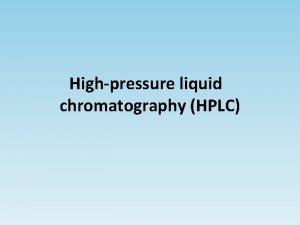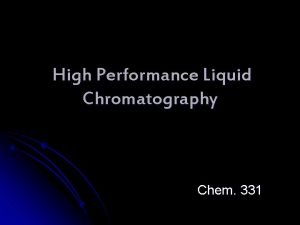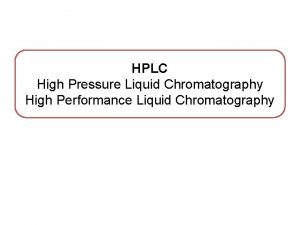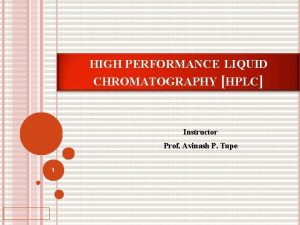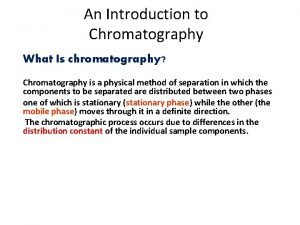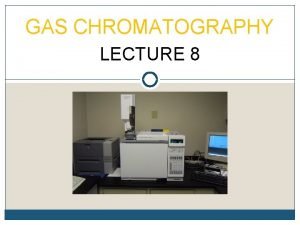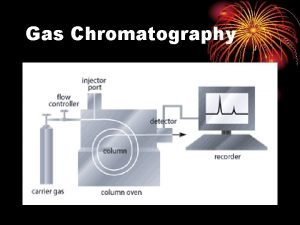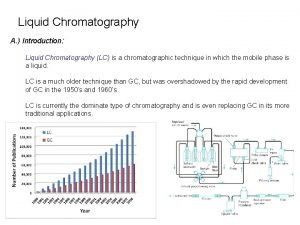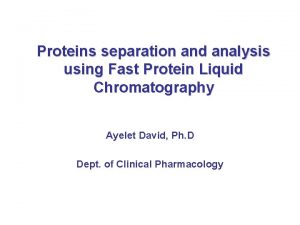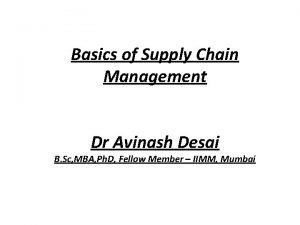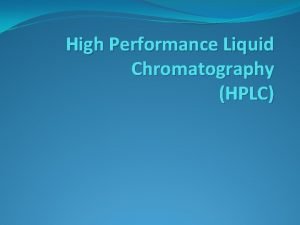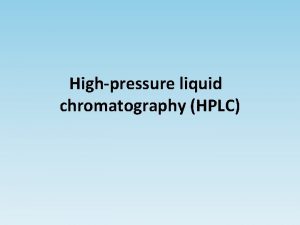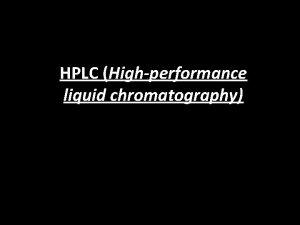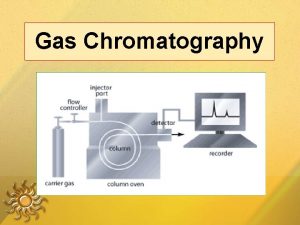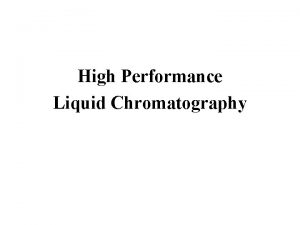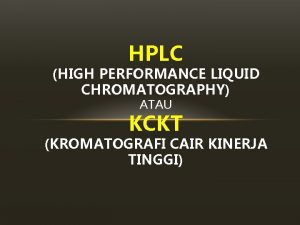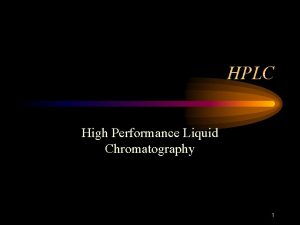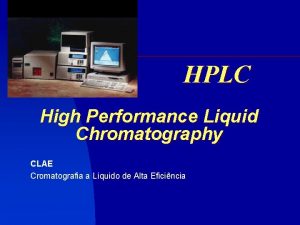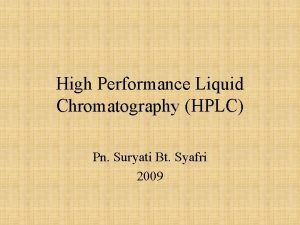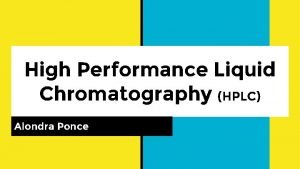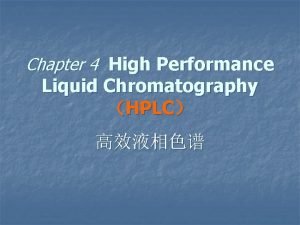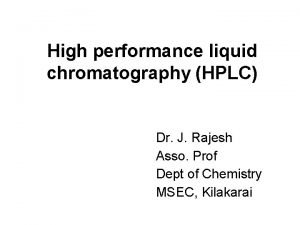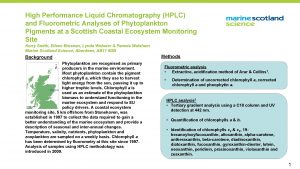HIGH PERFORMANCE LIQUID CHROMATOGRAPHY HPLC Instructor Prof Avinash
![HIGH PERFORMANCE LIQUID CHROMATOGRAPHY [HPLC] Instructor Prof. Avinash P. Tupe 1 HIGH PERFORMANCE LIQUID CHROMATOGRAPHY [HPLC] Instructor Prof. Avinash P. Tupe 1](https://slidetodoc.com/presentation_image_h2/525fb9d2241acf2455ed9304a31225f8/image-1.jpg)

















- Slides: 18
![HIGH PERFORMANCE LIQUID CHROMATOGRAPHY HPLC Instructor Prof Avinash P Tupe 1 HIGH PERFORMANCE LIQUID CHROMATOGRAPHY [HPLC] Instructor Prof. Avinash P. Tupe 1](https://slidetodoc.com/presentation_image_h2/525fb9d2241acf2455ed9304a31225f8/image-1.jpg)
HIGH PERFORMANCE LIQUID CHROMATOGRAPHY [HPLC] Instructor Prof. Avinash P. Tupe 1

Learning Outcomes 1) State the block diagram for HPLC system 2) Describe different components of HPLC system. 3) Classify different types of Pumps used in HPLC system.

BLOCK DIAGRAM OF Reservoir Pump HPLC Recorder Gradient controller Pump Fraction collector Analytical column Mixing chamber Solvent Conditioning column Detector Injector Precolumn 3

WHY USE HPLC Simultaneous analysis High resolution High sensitivity Good repeatability Moderate analysis condition Easy to fractionate and purify Not destructive 4

INSTRUMENTATION OF HPLC Solvent storage bottle Gradient controller and mixing unit De-gassing of solvents Pump Pressure gauge Pre-column Sample introduction system Column Detector Recorder 5

6

7

8

OUTLINE OF LC-2010 Reservior Tray Auto sampler System Controller Column Oven Degassing Unit UV detector Pump Unit Low pressure gradient device 23 23

SOLVENT/ MOBILE PHASE RESERVOIRS Glass or stainless-steel containers capable of holding up to 1 liter mobile phase (pure organic solvents or aqueous solutions of salts and buffers) Inert to a variety of aqueous and non aqueous mobile phases. Stainless steel should be avoided for use with solvents containing halide ions. 25

DEGASSING & FILTRATION OF MOBILE PHASE In many cases, aqueous solvents & some organic solvents are degassed prior to use Degassing is done to prevent formation of gas bubbles in the pump or detector ( Mobile phases are degassed by stirring of the mobile phase under vacuum, sonication or sparing with helium gas) The mobile phase are filtered to remove particulate matter that may clog the system Tubing Should be inert, have ability to withstand pressure able to carry sufficient volume 26

PUMP The solvents or mobile phase must be passed through a column at high pressures at up to 6000 psi(lb/in²) or 414 bar. As the particle size of stationary phase is smaller (5 to 10µ) the resistance to the flow of solvent will be high. That is, smaller the particle size of the stationary phase the greater is the resistance to the flow of solvents. Hence high pressure is recommended. 12

REQUIREMENTS FOR PUMPS Generation of pressure of about 6000 psi. Pulse free output & all materials in the pump should be chemically resistant to solvents. Flow rates ranging from 0. 1 to 10 m. L/min Pumps should be capable of taking the solvent from a single reservoir or more than one reservoir containing different solvents simultaneously. 13

Types of pumps used in HPLC DISPLACEMENT PUMPS RECIPROCATING PUMPS PNEUMATIC PUMPS 14

HPLC Pump Manner in which they operate Constant Pressure Pump (Pneumatic) Constant flow rate (Mechanical) Pump syringe (Displace ment pump) Single piston reciprocati ng pump Reciprocating pump Double piston reciprocating pump Direct pressure pump Amplifier pump Reciprocating diaphragm pump 15

DISPLACEMENT PUMPS � It consists of large, syringe like chambers equipped with a plunger activated by a screw driven mechanism powered by a stepping motor. � So it is also called as Screw Driven Syringe Type Pump. � Advantages: - It produces a flow that tends to be independent of viscosity & back pressure. � Disadvantages: - It has a limited solvent capacity(~250) & considerably inconvenient when solvents must be changed. 16

17

65
 High performance liquid chromatography hplc machine
High performance liquid chromatography hplc machine Limitations of liquid chromatography
Limitations of liquid chromatography Liquid chromatography definition
Liquid chromatography definition Hplc vs gas chromatography
Hplc vs gas chromatography Hplc chromatography principle
Hplc chromatography principle Introduction chromatography
Introduction chromatography Stationary phase in gas chromatography
Stationary phase in gas chromatography Gas liquid chromatography
Gas liquid chromatography Chromatography introduction
Chromatography introduction Fast protein liquid chromatography principle
Fast protein liquid chromatography principle Avinash kalyanaraman
Avinash kalyanaraman Avinash lakshman
Avinash lakshman Aea continuing education
Aea continuing education S66can
S66can Avinash sathaye
Avinash sathaye Dr avinash desai
Dr avinash desai Avinash college of commerce intermediate fee structure
Avinash college of commerce intermediate fee structure Avinash agarwal
Avinash agarwal Avinash lakshman education
Avinash lakshman education

